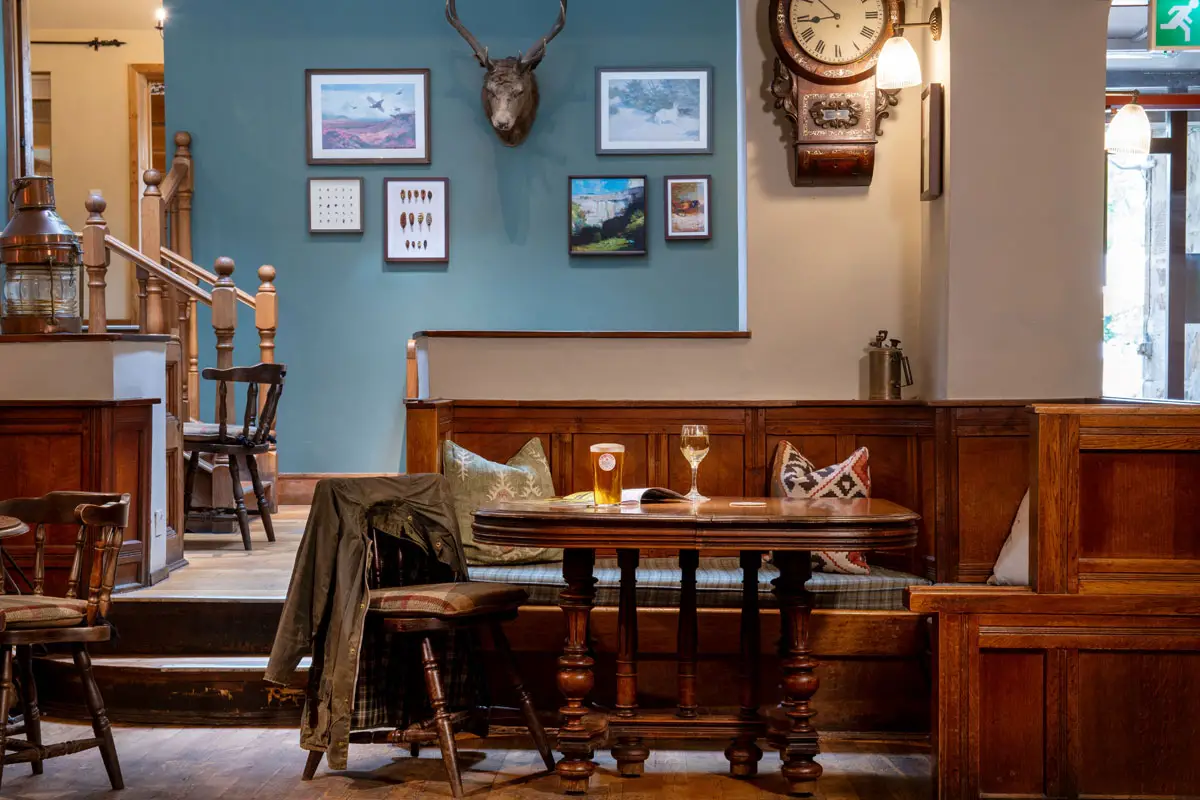The Red Lion at Burnsall, Wharfedale – Review

By Clare Jenkins, April 2024
There’s a scene in Alfred Hitchcock’s film, The 39 Steps, where hero Richard Hannay, handcuffed by ‘police’ to a woman he met on a train, hides with her under the arches of an ancient bridge in Scottish moorland, enveloped by fog.
First impressions of Burnsall are not dissimilar. The Red Lion’s address is By the Bridge – and while this particular stone bridge is longer and wider than Hannay’s, it’s still in the heart of picturesque dry-stone-wall countryside. It’s also the entrance to a ‘typical’ Yorkshire Dales village, whose handsome stone houses cluster around the long, low, 16th Century coaching inn, while the River Wharfe runs alongside, surrounded by fells and lonely expanses of moorland.
In the heart of the Dales, Burnsall is just a few miles from the popular market town of Grassington, ten miles from Pateley Bridge, a similar distance from Skipton, not much further from Malham. So it’s perfectly placed to explore all of them.
On our way there, we stopped off at Grassington to have cappuccino and chocolate brownies at the Cobblestones Café. The next table was occupied by a female version of the Last of the Summer Wine trio. “Are we all right?” asked one elderly lady. “Oh, I’ve had a belting day,” replied her friend. “I’ve been sorting out The Room and cleaning the church.” “I’ve been reading about a murder in our village,” said the third. “He was hung on a gibbet in the wood. It’s the only murder that’s ever happened in our village, thank goodness. I don’t know how they go on in Midsomer Murders…”
“Absorbing”
Inwardly praising DCI Barnaby, we drove on to Pateley Bridge, home to ‘the oldest sweet shop in England’ (dating back to 1661). Pateley seems the essence of Dales life, with its amateur dramatic society (latest production: Around the World in 80 Days), Great Cheese Auctions, cottages with roofs green with moss, cobbled courtyards and ginnels, a Victorian Oddfellows Hall and an Old Workhouse. You wouldn’t be surprised to pass Charlotte Bronte struggling back to the vicarage up the steeply winding street, ham hock in basket.
All that life is celebrated in the town’s absorbing Nidderdale Museum, ‘The local museum with lots to see’. It’s not an idle boast: displays celebrate the heritage of Dales villages, with fully-stocked recreations of a joiner’s shop, a pre-First World War grocery store, a schoolroom, Victorian parlour (complete with dresser stacked with blue and white china, tiled fireplace and table set for tea with cake and pork pie), pub and magistrates’ court. There’s a lavishly furnished doll’s house, a rare working Polyphon musical box, a penny-farthing bicycle, whole sets of George V and VI Coronation china, plus exhibitions on wartime, mining, quarrying, railways and religious life among the monks at nearby Fountains Abbey.
The town today doesn’t feel much different, with its Vale of Nidderdale Masonic Lodge (‘Making good men better since 1928’), 18th Century Talbot Hotel ‘with stabling for 15 horses’, herbal dispensary and overall sense of stern Methodism.
But time was getting on and we needed to check in to The Red Lion. Although the inn itself has 14 bedrooms, plus Riverside Cottages which can each sleep up to six people, we were allocated the ‘Feature Room’ on the top floor of the nearby mid-Victorian Manor House.
Climbing the steep, narrow stairs with two suitcases wasn’t easy, but it was worth the effort: after the brewery firm Daniel Thwaites bought the inn three years ago, it also spent £850,000 refurbishing the Manor House (the inn’s bedrooms are next on the list). Our suite, with oak beams, cream window slats and county-meets-Scandi décor, made inventive use of a relatively compact space, incorporating bedroom and sitting area, together with a bathroom containing both power shower and claw-foot bath, plus White Company toiletries.
“Extremely comfortable”
Both cosy and classy, if offered walker-sensible herringbone carpet, soft dove-grey curtains, William Morris-inspired leafy green wallpaper, an extremely comfortable double bed (covered in a lovely soft turquoise throw), clothes-rail in lieu of wardrobe, padded sofa with plaid cushions…
Other nice touches included home-made biscuits, a tabletop fridge, bedside tables with brass cow head handles, a hare’s-head hook in the bathroom, and Victorian bedside books: Brinton on Food & the Digestion, and The Seashore (Shown to the Children).
Had we wanted, we could have had a drink in the lounge before our meal; a Thwaites cask ale, perhaps, in a comfy armchair beside the log fire. On a better day, we might have sat at one of the wooden tables arranged outside and watched healthy walkers trekking the Dales Way, cyclists puffing up the hills.
Or, were we huntin’, shootin’, fishin’ folk, we could have had a pint or a malt whisky in the wood-panelled bar, surrounded by stuffed birds, stags’ heads and a mounted snarling fox. The various nooks and crannies are decorated with photos and paintings of sheepdogs and grouse, with hunting design cushions and framed displays of trout flies. Unsurprisingly, the inn is dog-friendly, with water bowls, dog-biscuits and -beds scattered around.
“Interesting display”
The restaurant was equally traditional, with striped and floral wallpaper, mahogany tables and upright wooden chairs. Food-wise, it offered a wide range of hearty food: from moules mariniere through game casserole to rib eye steak. Plus a good vegetarian selection: hummus and parmesan straws or goat’s cheese and sundried tomato bonbons for starters. For the main, vegetable hotpot with pickled red cabbage, or cheese, onion and potato pie, with chips and baked beans.
As we headed back to our room, we regretted not packing a torch as there’s (unsurprisingly) little street lighting. However, we did hear two owls hooting to each other in the night.
Breakfast – a good spread of fruit and cereals, and with creamy scrambled eggs – was in another wood-panelled room beside the river. Before leaving, we visited the 12th Century church of St Wilfrid, with its interesting display about the area’s Viking and Anglo-Saxon connections, including rare carved stones – and a tablet to Sir William Craven, 16th Century Lord Mayor of London, on whose rags-to-riches story Dick Whittington was based. Doubtless, Richard Hannay’s Mr Memory – the man who solved the mystery of The 39 Steps – could have told us all about him.
The Red Lion, By the Bridge, Burnsall, near Skipton BD23 6BU
01756-634542
redlion.co.uk
Double rooms from £130 B&B per night
Nidderdale Museum, The Old Workhouse, King Street, Pateley Bridge HG3 5LE
For opening hours, check nidderdalemuseum.com














